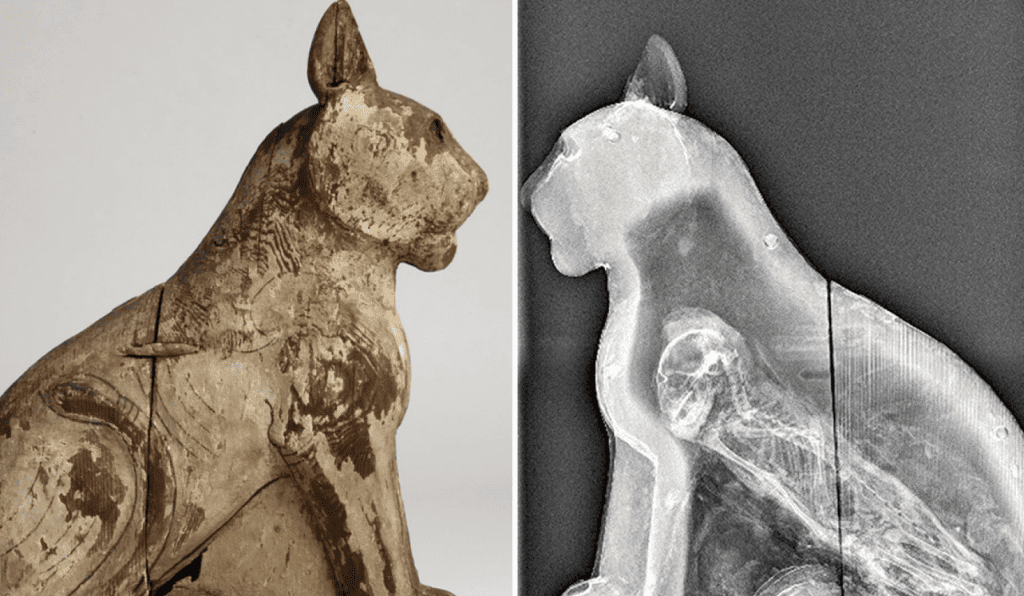University of Manchester researchers used X-rays and CT scans to look inside 800 animal mummies, some of which were more than 3,000 years old; they found that only a third actually contained an animal skeleton. Another third contained only fractions of a complete skeleton, sometimes just a single bone, while the rest were all mud casts, filled with twigs or other organic material, made to look like a real animal was inside. So, is this an exposed elaborate scam routine performed over the millenniums? Not quite – the researchers believe something more innocent is at play.

A mummified cat in a wooden casing. This is considered a rare sight, considering only a third of all animal mummies actually contain the remains of an animal. Image: University of Manchester
The ancient Egyptians were not only fond of mummifying their own remains, but those of pets as well. Cats, dogs, birds and so on. This was a practice common among the poor and wealthy alike. Those who could afford it would also encase the animal remains in elaborate coffins shaped as creatures, which the Egyptians believed represent the gods. The pets were depicted on tomb walls and were shown eating food or sitting under the chair of the deceased owner. Other depictions show the pets retrieving wild game shot down by their owners. Through these depictions we are able to see that pets were prized and loved just the same as in our modern societies.
However, beings pets were only part of the reason the animals were mummified. Cult animals that were worshiped in life would be mummified, as well as those mummified to serve as food for the owners in the after life (somehow, a fixed diet of monkey for all eternity doesn’t sound like a good idea, but at least you didn’t starve in Osiris’ underworld!). A forth category (the most numerous) is that of votive offerings. These animals were mummified as gifts to the gods alongside a prayer, sort of like Christians today light a candle.
“You would go to a special site, buy an animal mummy, using a system of barter. You’d then give it to a priest, who would collect a group of animal mummies and bury them,” explained Dr Campbell Price, curator of Egypt and Sudan, at Manchester Museum.
When the first animal mummies were discovered, some archaeologists naturally cut some to peer inside. To their surprise, they found many samples that were empty or contained only partial skeletons – a bone here and there. This led many to believe ancient embalmers were up to no good, scamming people. Price and colleagues decided to investigate just how many of the 70 million animal mummies discovered by excavators (!) were devoid of any actual animal remains. Many of these were found empty, though on the outside they resemble a complete animal.
“Basically, organic material such as mud, sticks and reeds, that would have been lying around the embalmers workshops, and also things like eggshells and feathers, which were associated with the animals, but aren’t the animals themselves.”
Considering millions and millions of animals were mummified or the appearance of such a ritual was undertaken, scientists believe that the fake mummies are the by-product of a lack of supply. The scale of the practice was huge, and most likely there were a lot of people whose sole job was that of raising animals, then slaughtering them as temple offerings. At some point, demand outgrew supply so the fake mummies was probably a poor’s man alternative. It’s not difficult to imagine some entrepreneurial Egyptian first thinking of implementing the practice, sparking a whole wave of these mummified produces. We buy cheap, plastic replicas of original artwork all the time. It’s fake, we know it’s fake, but we still buy it anyway.
“We think they were mummifying pieces of animals that were lying around, or materials associated with the animals during their lifetime – so nest material or eggshells,” Dr Lidija McKnight of University of Manchester told the BBC.
“They were special because they had been in close proximity with the animals – even though they weren’t the animals themselves.
“So we don’t think it’s forgery or fakery. It’s just that they were using everything they could find. And often the most beautifully wrapped mummies don’t contain the animal remains themselves.”









